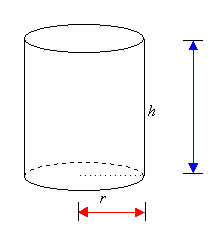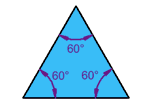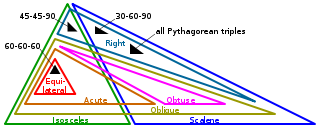Difference between revisions of "Triangles"
| Line 212: | Line 212: | ||
===Learning objectives=== | ===Learning objectives=== | ||
===Notes for teachers=== | ===Notes for teachers=== | ||
| − | Pythagoras' Theorem was discovered by Pythagoras, a Greek mathematician and philosopher who lived between approximately 569 BC and 500 BC. Pythagoras' Theorem states that: | + | # The GeoGebra file below verifies the Thales theorem <br> |
| + | {{#widget:YouTube|id=Y-6yYsuGLoc}} | ||
| + | # Pythagoras' Theorem was discovered by Pythagoras, a Greek mathematician and philosopher who lived between approximately 569 BC and 500 BC. Pythagoras' Theorem states that: | ||
In any right-angled triangle, the square of the hypotenuse is equal to the sum of the squares of the other two sides. That is: | In any right-angled triangle, the square of the hypotenuse is equal to the sum of the squares of the other two sides. That is: | ||
Revision as of 06:10, 26 December 2013
| Philosophy of Mathematics |
While creating a resource page, please click here for a resource creation checklist.
Concept Map
Error: Mind Map file Triangles .mm not found
Textbook
To add textbook links, please follow these instructions to: (Click to create the subpage)
Additional Information
Useful websites
This is a reference website for types and classification off triangles
A good website for quick reference of all theorems in geometry. Suitable for both students and teachers.
Reference Books
Teaching Outlines
Concept #1 A triangle and its properties
Learning objectives
- A triangle is one of the basic shapes of geometry: a polygon with three corners or vertices and three sides or edges which are line segments.
- It is the polygon with the least number of sides.
- A triangle can be defined as a polygon which has 3 sides, 3 angles and 3 vertices.
- The sum of any two sides is always greater than the third side.
- The angle opposite to longest side is the largest.
- The angles inside the triangle are its interior angles.
- The sum of all 3 interior angles in any triangle is always 180 degrees which is called the angle sum property of a triangle.
Notes for teachers
[These are short notes that the teacher wants to share about the concept, any locally relevant information, specific instructions on what kind of methodology used and common misconceptions/mistakes.]
- A triangle PQR consists of all the points on the line segment PQ,QR and RP. The three line segments, PQ, QR and RP that form
the triangle PQ, are called the sides of the triangle PQR.
- A triangle has three angles. In figure, the three angles are ∠PQR ∠QRP and ∠RPQ
- A triangle has six parts, namely, three sides,PQ QRand RP.Three angles ∠PQR ∠QRP and ∠RPQ. These are also known as the elements of a triangle.
- The point of intersection of the sides of a triangle is known as its vertex. In figure, the three vertices are P, Q and R. In a triangle, an angle is formed at the vertex. Since it has three vertices, so three angles are formed. The word triangle =tri + angle ‘tri’ means three. So, triangle means closed figure of straight lines having three angles.
Activity No # 1 Make your triangle
- Estimated Time - 40 minutes
- Materials/ Resources needed; Paper, pencil, and scale.
- Prerequisites/Instructions, if any:
- The students should know points and line segments.
- Multimedia resources
- Website interactives/ links/ Geogebra Applets
- Process (How to do the activity):
- Mark three non-collinear point P, Q and R on a paper.
- Join these points in all possible ways. The segments are PQ, QR and RP.
- A simple close curve formed by these three segments is called a triangle. It is named in one of the following ways.
- Triangle PQR or Triangle PRQ or Triangle QRP or Triangle RPQ or Triangle RQP .
- Developmental Questions (What discussion questions):
- What are plane figures ?
- What is a polygon ?
- How many points are needed to make a traingle ?
- Evaluation (Questions for assessment of the child):
- What are the intersecting points of a triangle called ?
- Can you draw a triangle with collinear points.
- Question Corner
- Name the elements of a triangle.
Activity No # 2. Angle sum property of a triangle
- Estimated Time: 40 minutes
- Materials/ Resources needed:Laptop, projector, geogebra file and a pointer.
- Prerequisites/Instructions, if any:
- The students should know a triangle and its elements.
- They should have prior knowledge about angles formed when a transversal cuts a pair of parallel lines and the relationship between them.
- Multimedia resources:Laptop
- Website interactives/ links/ Geogebra Applets:
- Process (How to do the activity):
- The teacher can initially recaptulate about a triangle, its vertices, sides and angles.
- Show them the geogebra file.
- Let them read the angles and find its sum
- By moving the vertices she can reiterate that the sum of angles in any triangle is always 180 degrees.
- To demonstrate this she can show them the two parallel lines across the triangle .
- Identify the transversal.
- Let them identify the two pairs of alternate angles from the figure.
- Developmental Questions (What discussion questions):
- Identify the geometric figures you see in the geogebra file.
- Identify the parallel lines.
- Identify the triangle embedded between the two parallel lines.
- Identify the 3 interior angles of the triangle.
- Name the transversal ?
- Name the types of angles formed at the point of intersection when a pair of parallel lines are intersected by a transversal.
- What are the relationship between such angles.
- Identify the 2 pairs of alternate angles.
- Why are alternate interior angles equal ?
- What is the sum of angles formed at point A ?
- What can you say about the 3 interior angles of a triangle ?
- How can we determine the relationship between the alternate angles and the interior angles of the triangle .
- Evaluation (Questions for assessment of the child):
- Can we prove the angle sum property of triangle by any other method. Discuss.
- Question Corner:
- Try proving the theorem by drawing different triangles.
- Cut on the outline of triangle.
- Cut out 3 angles of a triangle and join 3 vertices next to each other.
- Repeat for different triangles. What do you infer?
Concept #2 - Types of triangles
Learning objectives
- Triangles are classified into different types depending on their measures of sides and angles.
- Based on sides they can be scalene if all sides are of different lengths, isosceles if two sides are equal and equilateral if all 3 sides are of same length.
- Based on angles, the triangles are classified as Acute angled triangle if all of its angles are acute angled, Obtuse angled if any one of its angles is obtuse, right angled if one of its angles is 90 degrees and as equiangular if all its 3 angles are equal to 60 degrees.
- An equilateral triangle is equiangular as well.
Notes for teachers
These are short notes that the teacher wants to share about the concept, any locally relevant information, specific instructions on what kind of methodology used and common misconceptions/mistakes.
Activity No # 2 - Types of triangles - Identifying and naming
Part 1
- Estimated time - 20 minutes
- Materials/ Resources needed
- Prerequisites/Instructions, if any
- Multimedia resources
- Website interactives/ links/ Geogebra Applets
- Process (How to do the activity)
Identify and name the triangles in the above figure.
- Evaluation
- Is it possible to construct a triangle with 3 collinear points?
- Is it possible to construct a triangle whose sides are 3cm, 4cm and 9cm. Why?.
Part 2
- Estimated time - 20 minutes
- Materials/ Resources needed
- Prerequisites/Instructions, if any
- Multimedia resources
Look at the following images below

|

|

|

|

|

|
- Website interactives/ links/ Geogebra Applets
- Process (How to do the activity)
Identify and name the triangles in the above figure.
- Evaluation
- Can a scalene triangle also be a right-angled triangle ? If yes can you draw one ?
Activity No #
- Estimated Time
- Materials/ Resources needed
- Prerequisites/Instructions, if any
- Multimedia resources
- Website interactives/ links/ Geogebra Applets
- Process (How to do the activity)
- Developmental Questions (What discussion questions)
- Evaluation (Questions for assessment of the child)
- Question Corner
Activity No #
- Estimated Time
- Materials/ Resources needed
- Prerequisites/Instructions, if any
- Multimedia resources
- Website interactives/ links/ Geogebra Applets
- Process (How to do the activity)
- Developmental Questions (What discussion questions)
- Evaluation (Questions for assessment of the child)
- Question Corner
Concept #3 - Properties and Theorems: Pythagoras Theorem
Learning objectives
Notes for teachers
- The GeoGebra file below verifies the Thales theorem
- Pythagoras' Theorem was discovered by Pythagoras, a Greek mathematician and philosopher who lived between approximately 569 BC and 500 BC. Pythagoras' Theorem states that:
In any right-angled triangle, the square of the hypotenuse is equal to the sum of the squares of the other two sides. That is:
Pythagoras' Theorem in Three Dimensions
A three-dimensional object can be described by three measurements - length, width and height.

 We can use Pythagoras' Theorem to find the length of the longest straw that will fit inside the box or cylinder.
We can use Pythagoras' Theorem to find the length of the longest straw that will fit inside the box or cylinder.
Activity No #
- Estimated Time
- Materials/ Resources needed
- Prerequisites/Instructions, if any
- Multimedia resources
- Website interactives/ links/ Geogebra Applets
- Process (How to do the activity)
- Developmental Questions (What discussion questions)
- Evaluation (Questions for assessment of the child)
- Question Corner
Activity No #
- Estimated Time
- Materials/ Resources needed
- Prerequisites/Instructions, if any
- Multimedia resources
- Website interactives/ links/ Geogebra Applets
- Process (How to do the activity)
- Developmental Questions (What discussion questions)
- Evaluation (Questions for assessment of the child)
- Question Corner
Hints for difficult problems
Project Ideas
Math Fun
Usage
Create a new page and type {{subst:Math-Content}} to use this template


